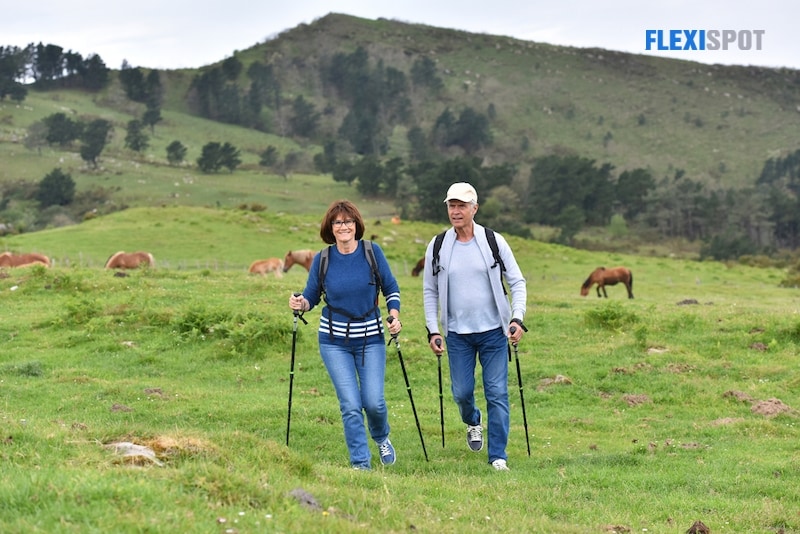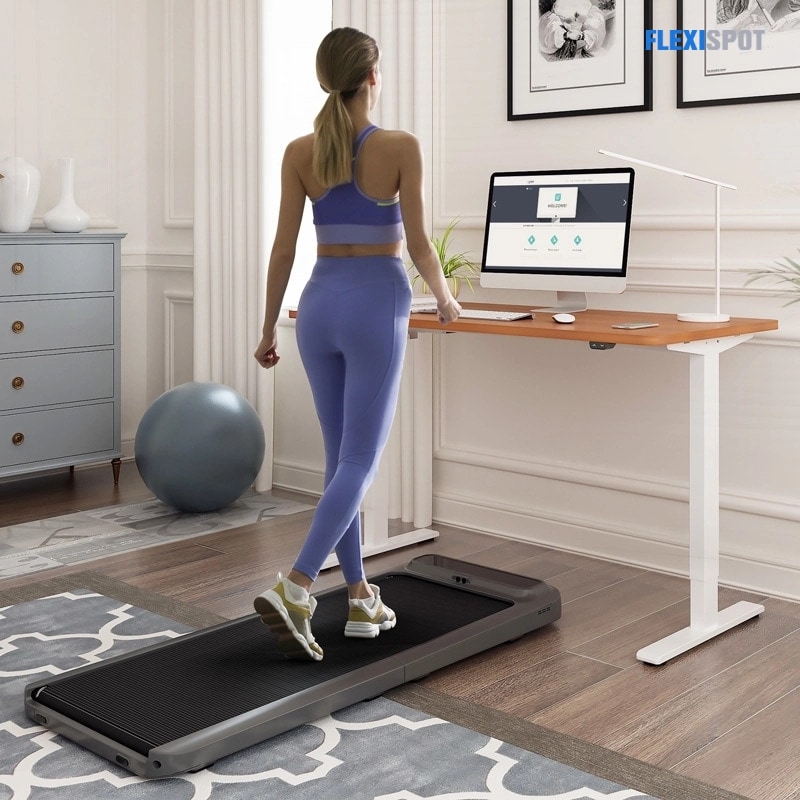One of the most potent techniques to maintain a healthy weight, stay strong, and live much longer is startilingly easy. It’s as simple as putting one foot in front of the other; even a toddler can do it. Walking is completely free. It’s simple to execute and gentle on the joints. And there’s no denying that walking is beneficial to your health. The calf serves as a venous pump, contracting and pumping blood from the legs and feet back to the heart, lessening the burden on the heart and lowering the chance of blood clots. Walking is beneficial in a variety of ways, in addition to being a simple cardiovascular workout.
Walking is straightforward enough that almost anyone who is able-bodied can do it. It also has a myriad of health advantages, like promoting a stronger immune system, increasing metabolism, and improving your joints, bones, and muscles—not to mention being great for relieving stress and enjoying some “me time.” What else can you expect if you start walking every day of the week?
Improvement on Circulation
Walking helps to prevent cardiovascular disease by increasing heart rate, decreasing blood pressure, and strengthening the heart. In just 24 weeks, postmenopausal women who walk one to two kilometers each day can drop their blood pressure by approximately 11 points. According to studies, women who walk 30 minutes a day can minimize their stroke risk by 20% and 40% if they increase their pace.
Mood Enhancement
Regular walking, according to research, alters your nerve system in such a way that you’ll feel less irritable and hostile, especially if you’re taking a stroll through some greenery or soaking up some sunshine. This is especially beneficial during the winter months when seasonal depression is more prevalent. Lastly, making your walks social—for example, striding with a neighbor, your partner, or a good friend—makes you feel more connected, which can cause you to feel happier.
Immune Function Boost
Walking can help you from catching a cold or flu. During the flu season, one study followed 1,000 adults. Those who walked for 30 to 45 minutes comfortably each day had 43 percent fewer sick days and lowered respiratory tract infections altogether. If they did become ill, their symptoms were also reduced. This was in comparison to sedentary adults in the research. To reap these benefits, try going for a daily stroll.
Muscle Strength
Walking strengthens your leg, abdomen, and arm muscles if you pump them while walking. This improves your mobility by transferring pressure and weight from your joints to your muscles.
Improvement in Breathing
Walking causes your respiratory rates to rise, forcing oxygen to move faster through your bloodstream, assisting in eliminating waste products and improving your energy and healing potential.
Joint Pain Alleviation
Walking can help to protect your hips and knees, as well as your joints. Because it lubricates and rejuvenates the muscles that make up the joints, it is beneficial. Walking may also provide health benefits for those with arthritis, such as pain relief. In addition, walking 5 to 6 kilometers per week may assist in reducing arthritic pain. The bulk of joint cartilage is not furnished with blood. It feasts on the fluid that circulates in our joints as we move. Walking “squeezes” the cartilage by pushing it and compressing it, allowing nutrients and oxygen to enter the area.
Calorie Burn
Even if the number on the scale isn’t dropping much, you may feel your jeans loosening around your stomach as you continue walking. According to a study, daily walking can significantly minimize abdominal fat and, as a consequence, enhance your body’s insulin release. Create a route that involves hills, alternate between speed walking and a slower pace when going outside, and encourage yourself to walk the same trails on consecutive days and see if you can surpass your previous ones. Aim for 10,000 steps per day for an extra injection of a drive.
You can increase metabolism by accelerating your speed for short periods during a 30-minute walk than if you walked at a reasonable pace for 30 mins. It’s also good for your cardiovascular and respiratory systems. Warm-up for 3 minutes before attempting to add intervals.
Brainpower Boost
Brain scans of persons who walked briskly for an hour three times a week revealed that their decision-making regions functioned more efficiently than those who attended education seminars instead. Another study found that when children walked on a treadmill for 20 minutes, their school performance increased. Experts believe that part of the reason for these advantages is the responsibility for pumping blood to the brain that comes from exercise.
Lower Blood Sugar
After you’ve eaten, go for a short stroll to reduce your blood sugar. A study indicated that walking for 15 minutes three times a day after meals lowered blood glucose levels more than walking for 45 minutes at another time of day. However, more research is required to corroborate these conclusions. Consider including a post-meal walk in your everyday routine. It can also assist you in incorporating daily physical activities.
Delay in Varicose Vein Onset
Varicose veins become more common as you get older. Walking, on the other hand, has been shown to help prevent them from growing. The venous system contains a circulation part in our leg and foot termed the “second heart,” which is composed of veins, muscles, and valves. Walking develops and preserves leg muscle, which increases healthy blood circulation, and this secondary circulatory process operates to pump blood back up to the heart and lungs. If you already have varicose veins, everyday walking can help relieve the inflammation and restlessness that comes with them. Walking every day can also help postpone the onset of varicose and/or spider veins if you are genetically prone to them.
Reduction in Risk of Chronic Diseases
According to the American Diabetes Association, Walking can help you lower your blood sugar levels and reduce your diabetes risk. According to some studies, every 1,000 daily steps taken can drop your systolic blood pressure by.45 points. When opposed to individuals who did not walk frequently, those who walked enough to meet guidelines for physical activity had a 30% lower risk of heart events such as stroke or heart attack, according to one of the most widely recognized studies on walking and health. Longer walks are essential for the prevention of illness. At least once or twice a week, take an hour-long walk.
Digestive System Stimulation
If you now favor coffee with maintaining your digestive system running smoothly, prepare to praise your morning walk instead. This is because walking daily can considerably enhance your bowel motions. Walking is one of the first things an abdominal surgery patient is encouraged to do because it engages the core and abdominal muscles while increasing GI movement.
Sleep Improvement
This is because melatonin, the sleep hormone, is typically enhanced by sleep. According to a 2019 study, postmenopausal women who engage in light to moderate-intensity physical exercise sleep better at night than inactive women. Walking also aids in the reduction of pain and tension, both of which can disrupt sleep.
Creative Thinking Enhancement
According to research, getting active is a smart idea whether you’re stuck at work or looking for a solution to a difficult situation. Taking a stroll can help you think more creatively. Researchers gave people creative thinking tasks while they sat and while walking and discovered that the walkers were more imaginative than the sitters.
Life Extension
Walking at a quicker speed may help you live longer. Researchers discovered that walking at a moderate pace lowered the chance of death by 20% compared to walking slowly. Walking at a fast speed (at least 4 miles per hour) significantly decreased the risk. The study looked at the link between quicker walking and parameters like cardiovascular disease, overall causes of death, and cancer death.
Walking While Working
Our apartments and houses have been converted into flexible workplaces as a result of the Covid chaos. However, the concern remains that isolation makes us more sedentary than ever before, putting our health on the line. If the weather is bad or you do not have the luxury to go for long walks outside, you can take them within, whether at home or at work. A treadmill walking pad with a standing desk is an excellent solution.
FlexiSpot Under-Desk Folding Treadmill Walking Pad
Getting your own treadmill workstation can be less expensive than paying $3600 for a gym membership. Consider exercising in private and making the most of your time by exercising in your own space and at your own pace. The following features are included in this treadmill walking pad by FlexiSpot:
- A display that can show up to five different types of information, such as time, speed, miles, steps, calories burnt, and so on, to help you keep count of your workouts.
- With ultrasonic sensors, it recognizes your whereabouts in real-time. The treadmill will slow down or possibly stop if the user moves too far back.
- A childproof lock protects your child from harm. In any mode, safety protection is enabled.
- The runway measures 47.2” x 18” and has a weight capacity of 220 lbs., letting you walk comfortably.
- The walking machine’s collapsed thickness is only 6.7 inches, making it easy to hide under a sofa.
- It may also be simply relocated to any area of the room thanks to the preinstalled wheels.
Walking can be used to meet the daily exercise requirements for persons of all ages and overall fitness. Pick an excellent walking path and a daily step target suitable for your age and level of fitness. To prevent injury, warm-up and cool down before walking. Before beginning a new exercise plan, always with your doctor.






